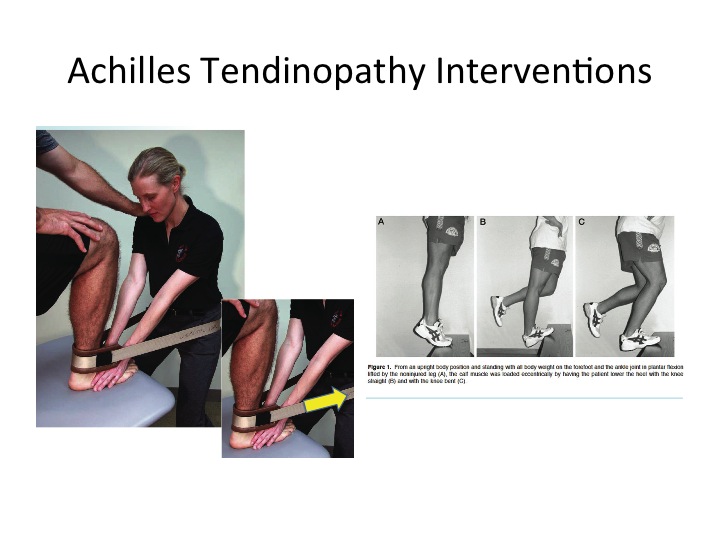Achilles Tendon Problems
Achilles tendinopathy commonly occurs in runners and jumpers, with up to 50% experiencing the condition in their lifetime(1).
Not all those affected are active with 33% of individuals reporting a sedentary lifestyle(2).
Individuals with this condition report pain, stiffness, and loss of function with daily and recreational activities.
This condition was originally thought to involve inflammation but more recent evidence suggests the presence of a degenerative tendinopathy(3,4). Remodeling (healing) of the achilles tendon has been found with appropriate loading through exercise, in particular eccentric contractions(5,6).
A Physical Therapy examination is able to determine the source of the symptoms as well as precipitating factors which caused the Achilles to be overloaded.
Physical Therapy interventions including manual therapy (spinal and extremity joint manipulation/mobilizations, soft tissue interventions including dry needling, education, and exercise are indicated in this condition.
Interventions are designed to reduce load on the tendon to allow for adaption and healing before slowly progressing the load on the tendon in preparation for return to activity.
Alfredson et al. initially described the positive effects of eccentric loading on pain and disability among recreational athletes. All athletes were able to return to pre injury levels after a 12 week program of strengthening (7).
Evidence
Systematic Reviews of the medical evidence report strong evidence for the eccentric loading program developed by Alfredson et al. but additional studies demonstrate success with other loading programs(8,10).
These programs have documented positive histological changes in the tendon consistent with remodeling and healing including increased stiffness, decreased thickness, and increased Type I collagen formation (5,6,8). These changes suggest the tendon is plastic and is able to adapt and improve with loading through exercise.
Physical Therapy was also superior to a corticosteroid injection for the treatment of Achilles Tendinopathy. Authors noted a 43% recurrence rate in the steroid group compared to a 16% recurrence rate in the PT group at long term follow up (12).
Referral to Physical Therapy
Research suggests pain on palpation of the achilles tendon, location of pain 2-6 cm above heel, and pain during heel raise testing are useful clinically in the diagnosis of achilles tendinopathy(11).
Patient’s with ankle and heel pain limiting daily and recreational activities should seek out Physical Therapy for the implementation of a manual therapy and eccentric exercise program.
References
1. Kvist M. Achilles-tendon injuries in athletes. Ann Chir Gynaecol 1991; 80: 188–201.
2. Kingma JJ, de Knikker R, Wittink HM et al. Eccentric overload training in patients with chronic Achilles tendinopathy: a systematic review. Br J Sports Med 2007; 41: e3.
3. Roos EM, Engstrom M, Lagerquist A et al. Clinical improvement after 6 weeks of eccentric exercise in patients with mid-portion Achilles tendinopathy – a randomized trial with 1-year follow-up. Scan J Med Sci Sports 2004; 14: 286–95.
4. Rees JD, Lichtwark GA, Wolman RL et al. The mechanism for efficacy of eccentric loading in Achilles tendon injury; an in vivo study in humans. Rheumatology 2008; 47: 1493–97.
5. Bohm, S. et al. Human Achilles tendon plasticity in response to cyclic strain effect of rate of duration. J Experimental Biology. 2014. 4010-4017.
6. Ohberg, L. et al. Eccentric training in patients with chronic Achilles tendinosis: normalized tendon structure and decreased thickness at follow up. Br J Sp Med. 2004. 38:8-11.
7. Alfredson, H. et al. Heavy load eccentric calf muscle training for the treatment of chronic Achilles tendinopathy. Am J Sp Med. 1998.
8. Habets, B et al. Eccentric exercise training in chronic mid portion tendinopathy: A systematic review on different protocols. Scand J Med Sci Sports. 2015. 25:3-15.
9. Malliaras, P. Achilles and Patellar Tendinopathy Loading Programs. A systematic review. Sports Med. 2013. 43:267-286.
10. Stevens M. et al. Effectiveness of the Alfredson protocol compared with a lower repetition- volume protocol for mid-portion Achilles tendi- nopathy: a randomized controlled trial. J Orthop Sports Phys Ther. 2014;44:45-57.
11. Hutchinson, A. et al. What is the best clinical test for Achilles tendinopathy? Foot and Ankle Surgery. 2013. 19:112-117.
12. Cantin D. et al. Corticosteroid inections and the treatment of Achilles tendonitis: A narrative review. Research in Sports Medicine. 2003. 11(2)79-97.


